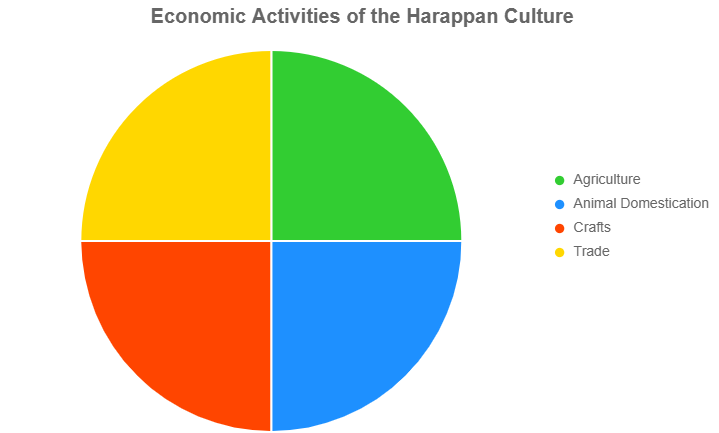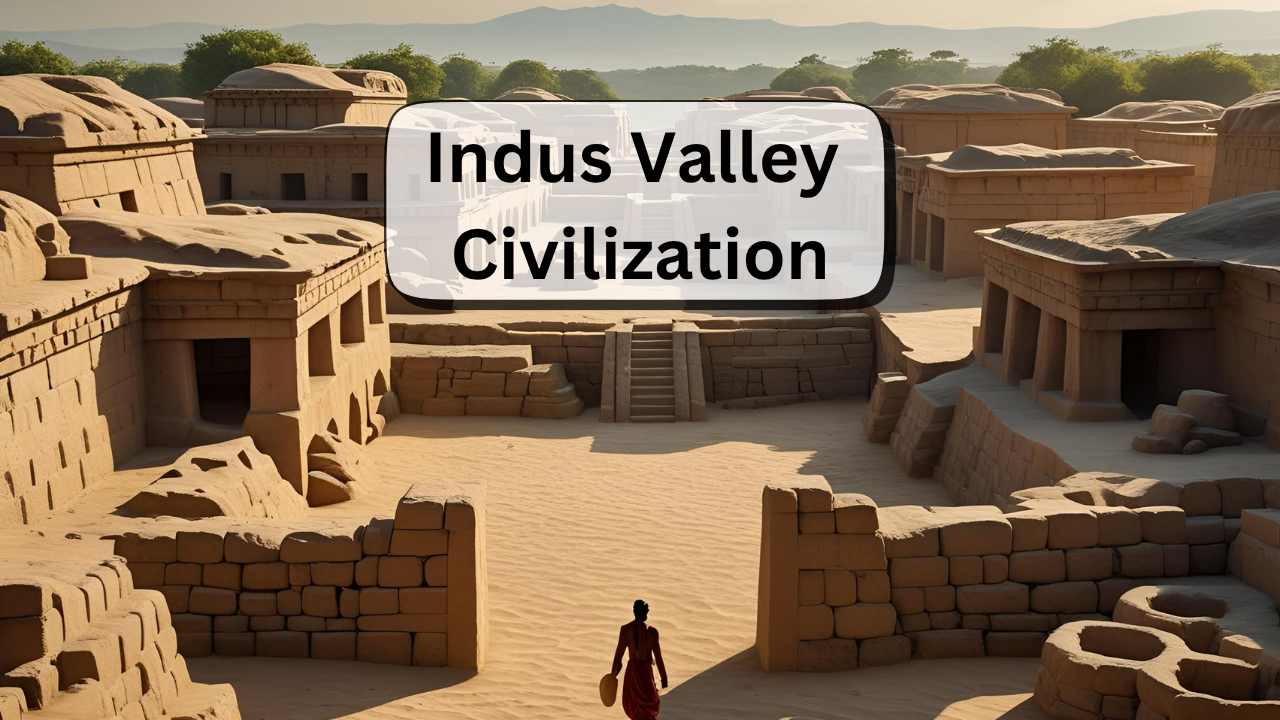The Indus Valley Civilization, also known as the Harappan Culture, stands as one of the earliest and most remarkable civilizations in human history. Flourishing around 5000 years ago in the northwestern regions of the Indian subcontinent, this civilization is a testament to the ingenuity and sophistication of its people. This article delves into the origin, date, extent, characteristics, decline, survival, significance, and the art and architecture of the Indus Valley Civilization.
Table of Contents
Origin of the Indus Valley Civilization
The Indus Valley Civilization emerged in the fertile plains along the Indus River and its tributaries, originating in the Himalayas and flowing southward into the Arabian Sea. Around 2500 BCE, people in this region began to settle and develop a highly organized society. The civilization’s origins are tied to favorable geographical conditions, including a moderate climate and fertile soil enriched by annual floods. These factors supported agriculture, which became the backbone of the Harappan economy.
The discovery of this civilization began in the early 20th century, with significant excavations at Harappa in 1921, followed by Mohenjodaro and other sites. These findings revealed a sophisticated urban culture that rivaled contemporary civilizations in Mesopotamia and Egypt. The civilization is named after Harappa, the first site discovered, as many subsequent sites shared similar cultural traits, leading historians to prefer the term “Harappan Culture” over “Indus Valley Civilization.”
Date and Chronology
The Harappan Culture thrived between 2500 BCE and 1800 BCE, with its mature phase occurring between 2200 BCE and 2000 BCE. This period marks the peak of its urban development, characterized by advanced town planning, trade, and craftsmanship. As a Bronze Age civilization, the Harappans extensively used copper and bronze tools, which facilitated advancements in agriculture, construction, and trade.
To visualize the timeline, imagine a horizontal line representing time, with key markers:
- 2500 BCE: Beginning of the Harappan Culture.
- 2200–2000 BCE: Mature phase with peak urban development.
- 1800 BCE: Decline of the civilization.

A timeline chart showing the Harappan Culture’s chronology, with markers for 2500 BCE (start), 2200–2000 BCE (mature phase), and 1800 BCE (decline). The chart should use a line format with clear labels and dates, using colors like blue and green for visibility on both light and dark backgrounds.
Extent of the Harappan Culture
The Harappan Culture spanned an impressive area of approximately 1,299,600 square kilometers, covering parts of modern-day Punjab, Haryana, Sindh, Baluchistan, Gujarat, Rajasthan, and western Uttar Pradesh. Its geographical reach extended from Jammu in the north to the Narmada estuary in the south, and from the Makran coast of Baluchistan in the west to Meerut in the northeast. This vast extent made it larger than the contemporary Egyptian and Mesopotamian civilizations.
Key sites include:
- Harappa (Punjab, Pakistan)
- Mohenjodaro (Sindh, Pakistan)
- Kalibangan (Rajasthan, India)
- Lothal (Gujarat, India)
- Dholavira (Gujarat, India)
These sites, discovered over time, revealed a shared urban culture, prompting the shift from calling it the Indus Valley Civilization to the Harappan Culture, as many sites were located far from the Indus River itself.
Characteristics of the Harappan Culture
The Harappan Culture was marked by several distinctive characteristics that highlight its advanced societal structure:
1. Geographical Factors
The prosperity of the Harappan Culture was closely linked to its geographical setting. Archaeological evidence, such as seals depicting plants and animals like elephants and rhinos, suggests a moderately wet climate 5000 years ago, unlike the arid conditions of the region today. The annual floods of the Indus River deposited rich alluvial soil, making the plains highly fertile for agriculture. This natural irrigation supported the growth of crops like wheat, barley, peas, and rice, ensuring food security and economic stability.
2. Town Planning
The Harappan cities were masterpieces of urban planning, a feature that sets them apart from other ancient civilizations. Excavations at Harappa and Mohenjodaro reveal cities divided into two parts:
- Citadel: Built on an elevated platform, likely housing administrative or religious structures.
- Outer City: The residential area at a lower level.
Key features include:
- Roads: Wide, straight roads intersected at right angles, facilitating efficient movement.
- Drainage System: A sophisticated network of covered drains ran along the roads, with water from houses flowing into them via well-constructed sinks.
- Houses: Built with burnt bricks, houses varied in size, indicating social stratification. They included wells and bathrooms, showcasing advanced sanitation.
- Public Structures: Notable structures include the Great Bath at Mohenjodaro, a large waterproof pool possibly used for religious rituals; a pillared hall at Mohenjodaro; a granary at Harappa for storing surplus grain; and a dockyard at Lothal, indicating maritime trade.
the Great Bath at Mohenjodaro, showing a large rectangular pool with steps leading down, surrounded by brick structures. The image should use earthy tones like brown and beige to reflect the archaeological setting.
3. Social Life
The Harappan society was complex, with evidence suggesting distinct social classes:
- Social Classes: The presence of small and large houses indicates a stratified society, with merchants likely forming the upper class and artisans and farmers the common people.
- Dress: While direct evidence is scarce, the discovery of spindles suggests the use of cotton and woolen fabrics. Bronze statues, such as that of a dancing girl, indicate women wore skirts and upper garments, while men wore loincloths and loose shoulder garments.
- Ornaments: Both men and women adorned themselves with necklaces, armlets, bangles, and finger rings made of gold, silver, ivory, precious stones, shells, bones, copper, and bronze. Hairpins and varied hairstyles were also prevalent.
- Recreation: The Harappans enjoyed dancing, music, and indoor games like dice. Numerous terracotta toys found at Mohenjodaro suggest a playful culture, particularly among children.
A depiction of a bronze statue of the dancing girl from Mohenjodaro, showcasing her attire and ornaments. The image should highlight her skirt, upper garment, and jewelry, using metallic shades for the bronze effect.
4. Economic Conditions
The Harappan economy was robust, driven by agriculture, animal domestication, crafts, and trade:
- Agriculture: The main occupation, with crops like wheat, barley, peas, and rice grown on flood-irrigated lands. Wooden ploughshares were used, though canal irrigation was absent.
- Domestication of Animals: Seals depict domesticated animals such as goats, buffaloes, oxen, elephants, dogs, and camels, but horses were likely unknown.
- Crafts: The Harappans excelled in bronze work, brick-making, masonry, and pottery. Pottery was wheel-made, decorated with red and black designs. Spinning and weaving were also common.
- Trade: A flourishing internal trade network existed, facilitated by the Indus River. External trade with Mesopotamian cities involved exporting grain, jewelry, and pottery and importing copper and precious stones. Harappan seals found in Mesopotamia confirm these trade links.

A chart illustrating the economic activities of the Harappans, divided into four segments: agriculture (wheat and barley), animal domestication (goats and oxen), crafts (pottery and bronze tools), and trade (ships and seals). Use a pie chart format with distinct colors like green, blue, red, and yellow.
5. Art of Writing
The Harappans developed a unique script, found on approximately 1500 terracotta seals. These small rectangular tablets feature pictorial writings alongside images of plants and animals. The script remains undeciphered, limiting our understanding of their literature and administration. The seals likely served as markers for trade or ownership.
An image of a Harappan seal from Kalibangan, showing a rectangular tablet with a bull figure and pictorial script. The image should use neutral tones to mimic the terracotta material.
6. Religious Practices
No temples have been found at Harappan sites, suggesting a decentralized religious practice. Archaeological finds include:
- Mother Goddess Figurines: Indicating worship of a female deity, possibly linked to fertility.
- Pashupati Seal: Depicting a male figure in a yogic posture with a trident-like headgear, surrounded by animals, resembling the Hindu god Shiva.
These findings suggest the Harappans may have worshipped deities similar to those in later Indian traditions, though definitive evidence is lacking.
Suggested Image 8: An illustration of the Pashupati seal, showing the yogic figure with animals and a trident headgear. Use dark and light contrasts to highlight the seal’s details.
7. Political Organization
Little is known about the Harappan political structure due to the undeciphered script. The absence of temples and the prominence of trade suggest that political power may have rested with an urban trading class rather than a centralized monarchy or priesthood. The well-organized cities indicate a sophisticated administrative system.
Decline of the Harappan Culture
The Harappan Culture began to decline around 1800 BCE, vanishing after a millennium of prosperity. Several theories attempt to explain this decline:
- Climatic Changes: A gradual shift to a drier climate may have rendered the region less hospitable, affecting agriculture.
- Natural Calamities: Floods or earthquakes could have destroyed key cities.
- Aryan Invasions: Some historians suggest conflicts with incoming Aryan groups contributed to the collapse, though evidence is inconclusive.
The most widely accepted view is that environmental changes, rather than a single catastrophic event, led to the gradual abandonment of cities.

A bar chart comparing the possible causes of decline (climatic changes, natural calamities, Aryan invasions) with their likelihood based on historical evidence. Use colors like blue, orange, and purple to differentiate the causes.
Survival and Significance
While the Harappan Culture declined, its legacy persists in various forms:
- Cultural Continuity: Some Harappan practices, such as the worship of deities resembling Shiva and the Mother Goddess, may have influenced later Indian religious traditions.
- Urban Planning: The sophisticated town planning and drainage systems set a precedent for urban development in the subcontinent.
- Trade Networks: The Harappans’ trade with Mesopotamia highlights their role in early global commerce, influencing economic systems in the region.
- Archaeological Importance: The discovery of Harappan sites has provided invaluable insights into early urban civilizations, contributing to our understanding of human history.
The Harappan Culture’s significance lies in its demonstration of human ingenuity in creating a complex, urban society without modern technology. Its study helps us appreciate the foundations of Indian civilization and the importance of environmental sustainability.
Art and Architecture
The Harappans’ art and architecture reflect their advanced skills and aesthetic sensibilities:
- Architecture:
- Burnt Bricks: Uniformly sized burnt bricks were used for construction, ensuring durability.
- Great Bath: A large, waterproof structure at Mohenjodaro, possibly used for religious or communal purposes, showcases engineering prowess.
- Granary and Dockyard: The granary at Harappa and the dockyard at Lothal indicate economic and maritime sophistication.
- Art:
- Seals: The terracotta seals, with their intricate animal and script designs, are among the finest examples of Harappan art.
- Sculpture: The bronze statue of the dancing girl and the bearded man demonstrate advanced metallurgical skills and artistic expression.
- Pottery: Wheel-made pottery, painted with red and black designs, reflects both utility and creativity.
- Jewelry: Ornaments made from diverse materials highlight the Harappans’ craftsmanship and trade connections.
Conclusion
The Indus Valley Civilization, or Harappan Culture, represents a pinnacle of early human achievement. Its well-planned cities, advanced economy, and intricate art and architecture reveal a society that was both practical and creative. Despite its decline around 1800 BCE, its legacy endures in the cultural and historical fabric of the Indian subcontinent. By studying this civilization, we gain insights into the ingenuity of our ancestors and the importance of adapting to environmental changes. The Harappan Culture remains a beacon of human progress, inspiring awe and curiosity for generations to come.
Relevant post: The Sources Of Ancient Indian History
